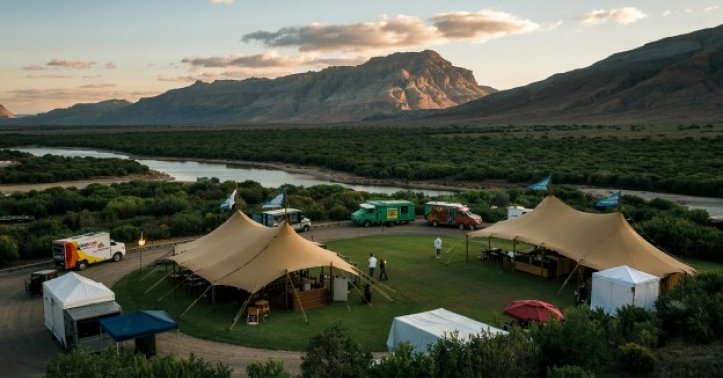
5 Tips To Host An Epic Remote Retreat
Ever dreamt of taking your team, your crew, or your community off the grid for a few days of real connection?
A remote retreat is the perfect way to unplug from chaos and plug into what actually matters—creativity, collaboration, nature, and maybe a little bit of wine by the fire.
But here’s the thing: when you’re far from Wi-Fi and Uber Eats, small details can turn into big headaches fast. You need more than good vibes—you need a solid plan. The kind of plan that makes people say, “That was epic” on the way home.
Whether you’re planning a company getaway, a wellness weekend, or a content creator campout, these five tips will help you host a retreat that’s smooth, stress-free, and seriously unforgettable. Let’s make magic in the middle of nowhere—without losing your cool (or your catering).
1. Choose a Location with Intent
Don’t just pick a random cabin in the woods because it looks pretty on Instagram. Your location sets the tone for the whole retreat.
● Are you trying to inspire deep work? Go somewhere quiet with minimal distractions.
● Want to spark creativity? Think wide open spaces, cool architecture, or a place with a little weirdness to it.
● Looking to help people bond? A shared house on the beach or a cozy mountain lodge with one giant table can work wonders.
Also, consider the logistics. How far is it from the airport? Will people need 4x4s to get there? Is there actual cell service, or will you need to bring a satellite connection? Remote doesn’t have to mean “impossible to reach.”
A good rule of thumb: you want the location to feel like an adventure but not a survival test. You can also set up a mobile shipping container office for coordination.
Oh—and bonus points if the place has a killer sunrise view, outdoor hangout space, or somewhere to take group photos. You’re not just hosting a retreat. You’re creating memories. Pick a place where people will feel long after they leave.
2. Rent a Refrigerated Container for Food Storage
Here’s something most people don’t think about until it’s too late: food logistics. When you’re hosting a retreat in the middle of nowhere, you can’t rely on last-minute grocery runs or hope your cooler keeps everything cold. If you’re bringing in chefs, food trucks, or even just prepping meals yourself, you need cold storage that won’t flake out on you.
That’s where renting a refrigerated container (aka a walk-in cooler) comes in clutch. It’s basically a giant fridge you can park on-site. Your vendors can stash everything—from fresh produce to ice cream—without fighting over a tiny Airbnb fridge. It also keeps things safe, clean, and up to health code if you’re feeding a group.
Plus, it gives you way more flexibility. Want a juice bar one day and a taco truck the next? No problem—they’ve got a place to store ingredients between shifts.
It might not be the sexiest part of planning, but trust us: fresh food and cold drinks = happy guests. Renting a refrigerated container is one of those power moves that makes you look like you’ve done this before—even if it’s your first rodeo.
3. Curate the Experience, Not Just the Schedule
It’s easy to get caught up building a perfect agenda—hour-by-hour plans, color-coded calendars, maybe even a Google Sheet (or five). But here’s the secret: People don’t remember schedules—they remember feelings.
So, instead of obsessing over every minute, think about how you want people to feel at different moments. Energized in the morning? Set up a cozy coffee station with playlists and sunrise yoga. Deep focus after lunch? Create quiet zones with comfy chairs, shade, and good vibes. Want connection at night? Light a fire pit, set out blankets, and let the conversations flow.
Leave space for magic. Spontaneous hikes, late-night jam sessions, mid-afternoon naps—they all matter more than a packed itinerary. Build in buffer time so people don’t feel rushed.
And bring little touches that make the retreat feel special: a welcome kit, handwritten notes, a communal journal, hammocks under the trees, and string lights at dinner. These details cost almost nothing but add a ton of soul.
Remember, you’re not just hosting an event—you’re designing a shared experience. The kind that makes people feel more human, more connected, and way more likely to say, “I’m coming to the next one.”
4. Bring Your Own Infrastructure
When you’re out in the middle of nowhere, assume nothing is provided. No power? No Wi-Fi? No lights after sunset? Yeah, that’s probably the case. But it’s not a dealbreaker if you come prepared.
First, power. Bring a generator or two. Bonus if they’re quiet ones, so they don’t kill the vibe. For charging phones, laptops, or speaker gear, portable battery banks work great.
Next, the internet. If you need it, bring something like Starlink. It’s fast, it works almost anywhere, and it’ll save you when someone has to send a last-minute file or run a live stream.
Also, think about lighting. A few string lights, headlamps, or solar lanterns go a long way. Don’t forget extra extension cords, duct tape, and surge protectors—you’ll use them all, promise.
And finally, the boring-but-important stuff: trash bags, first aid kits, bug spray, sunscreen, extra toilet paper. It’s not glamorous, but it’s what keeps things running smooth.
Bottom line: Pretend you're setting up a tiny village. The more you bring, the less you stress when you're out there. Your future self—and your guests—will thank you.
5. Document the Magic
You put all this effort into creating something unforgettable—don’t let it vanish once everyone packs up. Capture the moments. The awkward laughs, the golden hour dinners, the weird inside jokes. That’s the real gold.
Hire a content creator if your budget allows. Someone who can float around quietly snapping photos, filming quick clips, and maybe even cutting a short highlight reel. If that’s not in the cards, assign someone on your team to be the unofficial memory keeper. Just make sure someone’s documenting!
Encourage guests to take their own photos, too, but don’t overdo the “social media moment” thing. This isn’t Coachella. It’s about real connection. That said, set up one or two photogenic spots—string lights, a cool backdrop, even a Polaroid station. People love that stuff.
After the retreat, share the memories. A Dropbox link, a group photo dump, a short video recap—whatever fits the vibe. It helps everyone relive the magic and builds hype for the next one.
Bottom line: Memories fade, but content lives forever (or at least until the next retreat). Capture it while it’s happening. You’ll be glad you did.
A remote retreat isn’t just a getaway—it’s a chance to hit pause, reset, and bring people closer in a way Zoom calls never will. But pulling it off takes more than good intentions. You need the right space, the right setup, and a plan that covers both the magic and the messy stuff.
When you choose your location with care, prep your food game with a refrigerated container, curate meaningful moments, bring the gear that keeps everything running, and document the experience, you set yourself up for something truly epic.
People won’t remember the perfect schedule. They’ll remember how it felt to be there.
So, go all in. Plan like a pro. And then let the good stuff unfold naturally.
Because when it’s all over, they won’t just thank you. They’ll ask when you’re doing it again.








